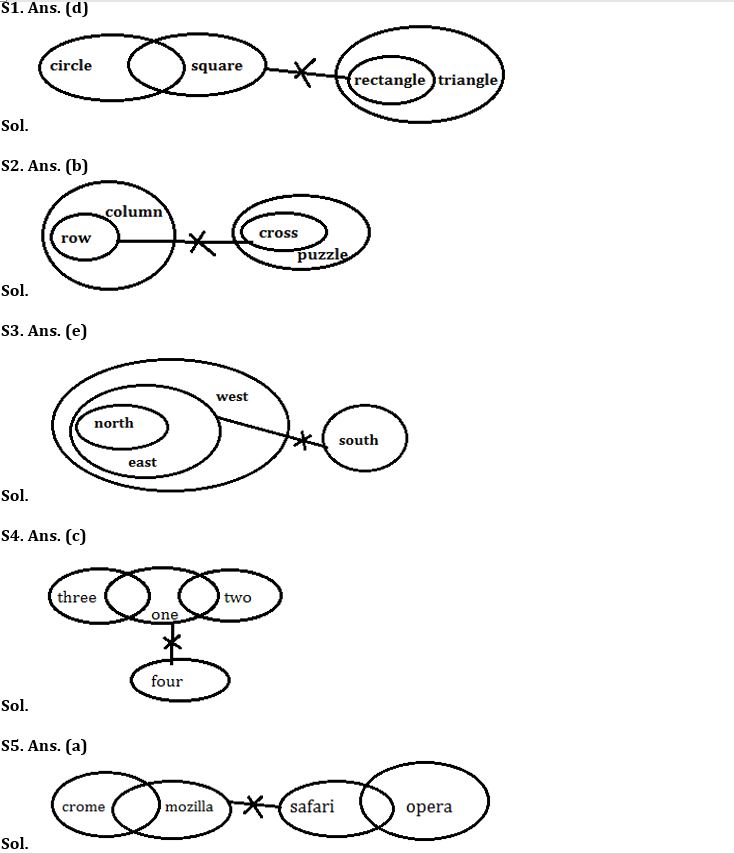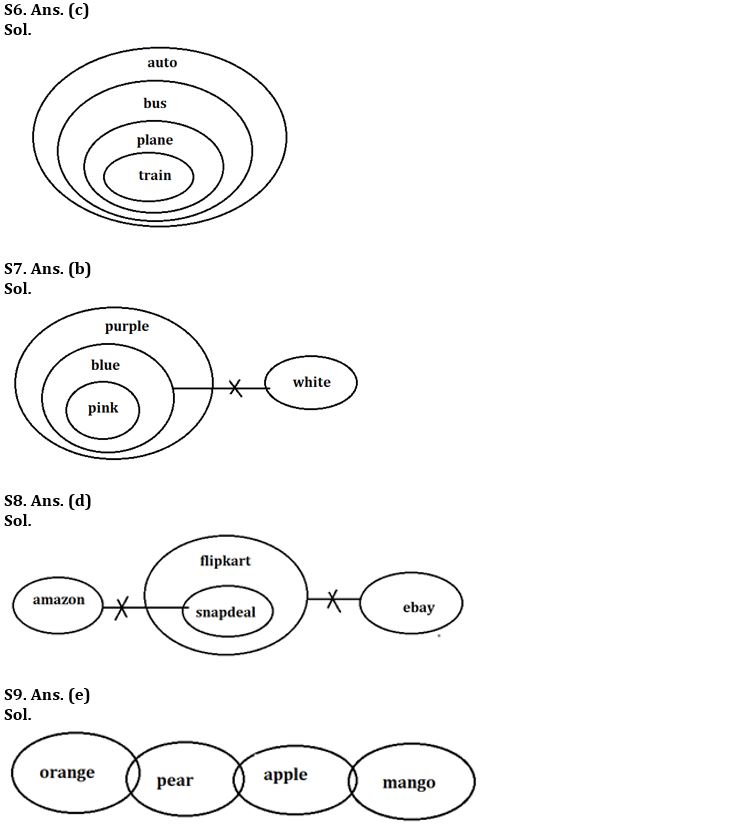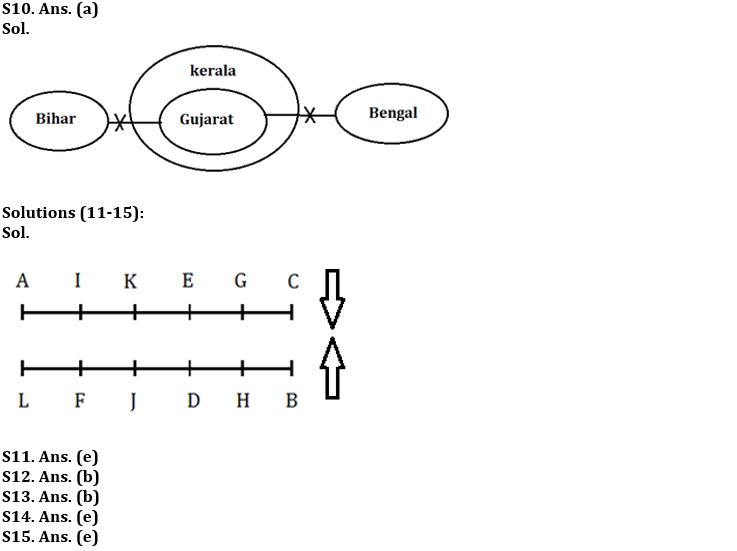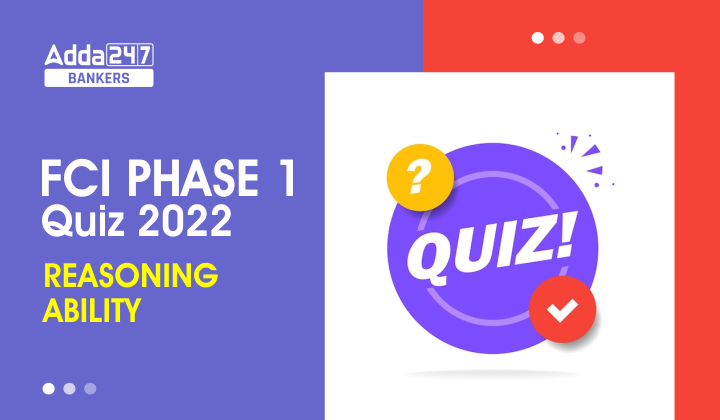Directions (1-5): In each of the questions below some statements are given followed by two conclusions. You have to take the given statements to be true even if they seem to be at variance with commonly known facts. Read all the conclusions and then decide which of the given conclusions logically follows from the given statements, disregarding commonly known facts. Give answer
(a) If only conclusion I follows.
(b) If only conclusion II follows.
(c) If either conclusion I or II follows.
(d) If neither conclusion I nor II follows.
(e) If both conclusions I and II follow.
Q1. Statements: Some circle are square
No square are rectangle
All rectangle are triangle
Conclusions: I. Some circle are rectangle
II. No square is triangle
Q2. Statements: All row are column
No row is cross
All cross are puzzle
Conclusions: I. No row is puzzle
II. Some column are cross is a possibility.
Q3. Statements: All north are east
All east are west
No east is south
Conclusions: I. No north is south
II. Some west are not south
Q4. Statements: Some three are one
Some one are two
No one is four
Conclusions: I. Some three are two
II. No three are two
Q5. Statements: Some crome are mozilla
No mozilla are safari
Some safari are opera
Conclusions: I. Some crome are safari is a possibility
II. No opera is mozilla.
Direction (6-10): In each of the questions below some statements are given followed by two conclusions. You have to take the given statements to be true even if they seem to be at variance with commonly known facts. Read all the conclusions and then decide which of the given conclusions logically follows from the given statements disregarding commonly known facts.
Q6. Statements: All train is plane.
All plane is bus.
Some bus is auto.
Conclusions: I. Some auto is plane.
II. No auto is plane.
(a) If only conclusion I follows.
(b) If only conclusion II follows.
(c) If either conclusion I or II follows.
(d) If neither conclusion I nor II follows.
(e) If both conclusions I and II follow.
Q7. Statements: All pink is blue.
All blue is purple.
No blue is white.
Conclusions: I. Some purple can be white.
II. Some pink can be white.
(a) If only conclusion II follows.
(b) If only conclusion I follows.
(c) If neither conclusion I nor II follows.
(d) If either conclusion I or II follows.
(e) If both conclusions I and II follow.
Q8. Statements: No amazon is snapdeal.
All snapdeal is flipkart.
No flipkart is ebay.
Conclusions: I. Some amazon is flipkart.
II. All snapdeal can be ebay.
(a) If either conclusion I or II follows.
(b) If only conclusion I follows.
(c) If both conclusion I and II follows.
(d) If neither conclusion I nor II follows.
(e) If Only conclusion II follow.
Q9. Statements: Some orange is pear.
Some pear is apple.
Some apple is mango.
Conclusions: I. Some mango can be orange.
II. Some pear is not apple.
(a) If only conclusion II follows.
(b) If both conclusion I and II follows
(c) If neither conclusion I nor II follows.
(d) If either conclusion I or II follows.
(e) If only conclusion I follows.
Q10. Statements: No Bihar is Gujarat.
No Gujarat is Bengal.
All Gujarat is Kerala.
Conclusions: I. Some Kerala can be Bihar.
II. All Bengal can be Kerala.
(a) If both conclusion I and II follows.
(b) If only conclusion I follows.
(c) If neither conclusion I nor II follows.
(d) If either conclusion I or II follows.
(e) If only conclusion II follows.
Directions (11-15): Read the following information carefully and answer the questions given below:
Twelve people are sitting in two parallel rows containing six people. In row 1 – A, I, G, K, E and C are seated (but not necessarily in the same order) and all of them are facing south. In row 2 – L, H, D, J, B and F are seated (but not necessarily in the same order) and all of them are facing north. Each member seated in one row faces another member of the other row.
E sits 2nd to the right of C and doesn’t face J. A sit at one of the ends and diagonally opposite to B. Three persons sit between B and F who does not face G. Neither E nor C is an immediate neighbor of A. J sits immediate left to D but does not face C. Two persons sit between I and G, none of them sits at the end. The one who faces K sits 2nd right to L.
Q11. Who among the following faces C?
(a) G
(b) K
(c) I
(d) A
(e) none of these
Q12. How many persons sit to the right of H?
(a) No One
(b) one
(c) two
(d) three
(e) four
Q13. Four of the following five form a group, who among the following does not belongs to that group?
(a) B
(b) K
(c) C
(d) A
(e) L
Q14. If in a certain way A is related to J, K is related to H, then who among the following is related to D?
(a) G
(b) K
(c) H
(d) F
(e) I
Q15. Who among the following sit 3rd right to K?
(a) A
(b) K
(c) E
(d) C
(e) No one
Solutions








 GA Capsule for SBI Clerk Mains 2025, Dow...
GA Capsule for SBI Clerk Mains 2025, Dow...
 The Hindu Review October 2022: Download ...
The Hindu Review October 2022: Download ...
 ECGC PO Scorecard 2025 Out, Check Marks
ECGC PO Scorecard 2025 Out, Check Marks




